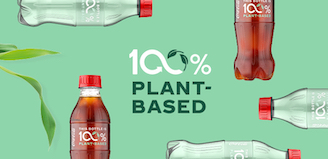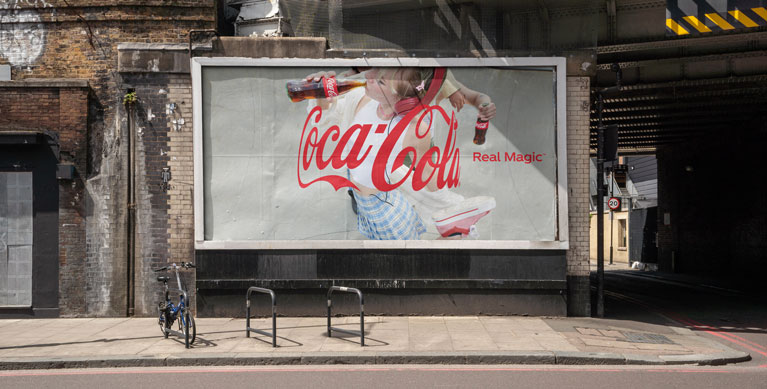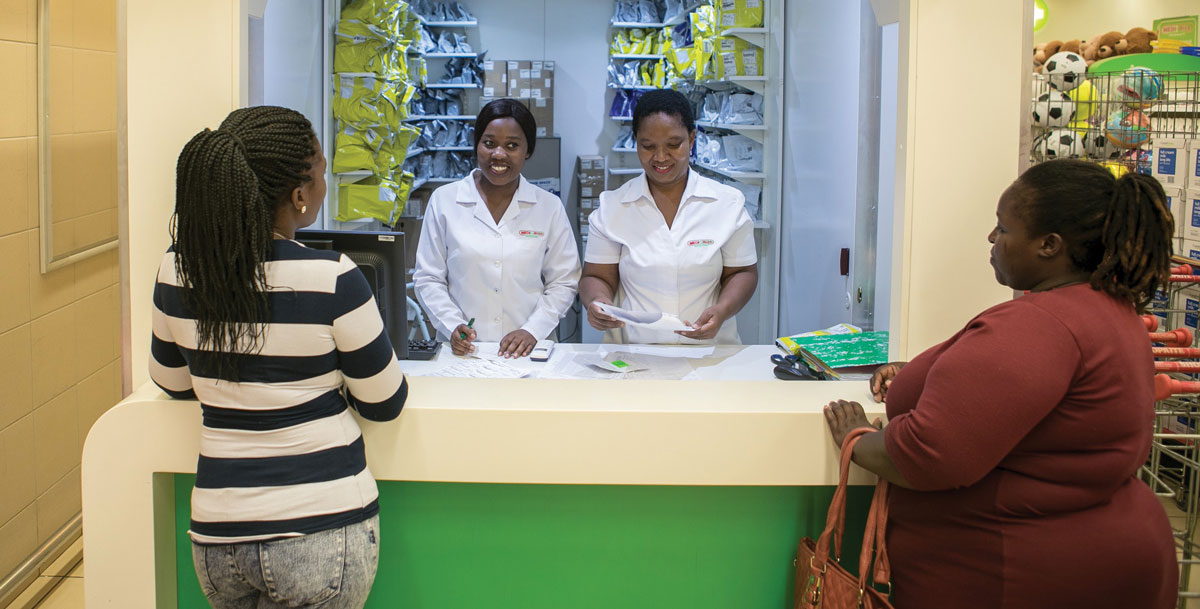Coca‑Cola Reports Fourth Quarter and Full-Year 2021 Results
02-10-2022
Global Unit Case Volume Grew 9% for the Quarter and 8% for the Full Year
Net Revenues Grew 10% for the Quarter and 17% for the Full Year;
Organic Revenues (Non-GAAP) Grew 9% for the Quarter and 16% for the Full Year
Operating Income Declined 28% for the Quarter and Grew 15% for the Full Year;
Comparable Currency Neutral Operating Income (Non-GAAP) Declined 12% for the Quarter and Grew 12% for the Full Year
Fourth Quarter EPS Grew 65% to $0.56, and Comparable EPS (Non-GAAP) Declined 5% to $0.45;
Full-Year EPS Grew 26% to $2.25, and Comparable EPS (Non-GAAP) Grew 19% to $2.32
Cash Flow from Operations Was $12.6 Billion for the Full Year, Up 28%;
Full-Year Free Cash Flow (Non-GAAP) Was $11.3 Billion, Up 30%
Company Provides 2022 Financial Outlook
ATLANTA, Feb. 10, 2022 – The Coca‑Cola Company today reported fourth quarter and full-year 2021 results, including another quarter of sequential improvement in volume trends compared to 2019. “In 2021, our system demonstrated resilience and flexibility by successfully navigating through another year of uncertainty,” said James Quincey, Chairman and CEO of The Coca‑Cola Company. “We focused on our key strategies and emerged stronger. We are confident that progress on our strategic transformation has made us a nimbler total beverage company. While the environment remains dynamic, we will build on the momentum from 2021 to drive topline growth and maximize returns.”
Highlights
Quarterly / Full-Year Performance
- Revenues: For the quarter, net revenues grew 10% to $9.5 billion, resulting in net revenues ahead of 2019, and organic revenues (non-GAAP) grew 9%. Revenue performance included 10% growth in price/mix and a decline of 1% in concentrate sales. The quarter included six fewer days, which resulted in an approximate 6-point headwind to revenue growth. The quarter was also impacted by the timing of concentrate shipments. For the full year, net revenues grew 17% to $38.7 billion, and organic revenues (non-GAAP) grew 16%. This performance was driven by 9% growth in concentrate sales and 6% growth in price/mix.
- Margin: For the quarter, operating margin, which included items impacting comparability, was 17.7% versus 27.2% in the prior year, while comparable operating margin (non-GAAP) was 22.1% versus 27.3% in the prior year. For the full year, operating margin, which included items impacting comparability, was 26.7% versus 27.3% in the prior year, while comparable operating margin (non-GAAP) was 28.7% versus 29.6% in the prior year. For both the quarter and the full year, operating margin compression was primarily driven by a significant increase in marketing investments versus the prior year. Additionally, fourth quarter operating margin was impacted by topline pressure from six fewer days in the quarter along with the timing of concentrate shipments.
- Earnings per share: For the quarter, EPS grew 65% to $0.56, and comparable EPS (non-GAAP) declined 5% to $0.45. For the full year, EPS grew 26% to $2.25, and comparable EPS (non-GAAP) grew 19% to $2.32. Both fourth quarter and full-year comparable EPS (non-GAAP) performance included the impact of a 2-point currency tailwind.
- Market share: For both the quarter and the full year, the company gained value share in total nonalcoholic ready-to-drink (NARTD) beverages, which included share gains in both at-home and away-from-home channels. The company’s value share in total NARTD beverages, and in both at-home and away-from-home channels, remains ahead of 2019.
- Cash flow: Cash flow from operations for the year was $12.6 billion, up $2.8 billion versus the prior year, driven by strong business performance and working capital initiatives. Full-year free cash flow (non-GAAP) was $11.3 billion, up $2.6 billion versus the prior year, driven by strong cash flow from operations.
Company Updates
- Business environment: Compared to 2019, global unit case volume sequentially improved each quarter in 2021, resulting in full-year unit case volume being ahead of 2019. This performance was driven by ongoing, asynchronous recovery in many markets and the company’s ability to better adapt to successive waves of the pandemic. The fourth quarter marked the first quarter in which away-from-home volume was ahead of 2019, while strength in at-home channels also continued. Although reopenings continue to vary across the world, the company is combining the power of scale with the deep knowledge required to win locally and is continuing to invest ahead of the recovery in a targeted way.
- Strengthening a consumer-centric portfolio through strategic acquisitions: During the fourth quarter, the company acquired the remaining 85% ownership interest in BODYARMOR, a line of sports performance and hydration beverages that has significant potential for long-term growth. Since gaining access to the company’s bottling system three years ago, BODYARMOR has driven continuous innovation in hydration products. For full-year 2021, BODYARMOR was the #2 sports drink in the category in measured retail channels in the United States, with retail value growth of approximately 50%. BODYARMOR will continue to be distributed by the company’s U.S. bottling system and will be managed as a separate business within the company’s North America operating unit.
- Transforming and modernizing marketing through one global marketing network partner: After an extensive review in 2021, the company named WPP as its global marketing network partner. WPP will play a key role in executing a new marketing model to drive long-term growth for the company’s global portfolio of brands. The new, integrated agency model is consumer-centric and leverages the power of big, bold ideas and creativity within experiences. The company intends to create end-to-end experiences that are grounded in data-rich consumer insights, optimized in real-time and implemented at scale. WPP, supported by a common data and technology platform that connects marketing teams throughout the company, will work with a strategic roster of approved agencies to provide access to the best creative minds and ideas.
- Further embedding sustainability into the business, including a new packaging target: The company’s environmental, social and governance (ESG) goals are embedded in operations and serve as key drivers of growth. To complement and support its World Without Waste goals, the company announced a new, global goal to reach 25% reusable packaging by 2030. Reusable packaging, including refillable containers for dispensed/fountain along with refillable or returnable glass and plastic bottles, supports the company’s collection goals and contributes to reducing the company’s carbon footprint, while aligning with consumer preferences for sustainable packaging options. Increasing reusable packaging and dispensed options responds to both consumer affordability and sustainability preferences, making it one of several important commercial levers to help achieve the company’s World Without Waste goals and contribute to the circular economy.
Operating Review – Three Months Ended December 31, 2021
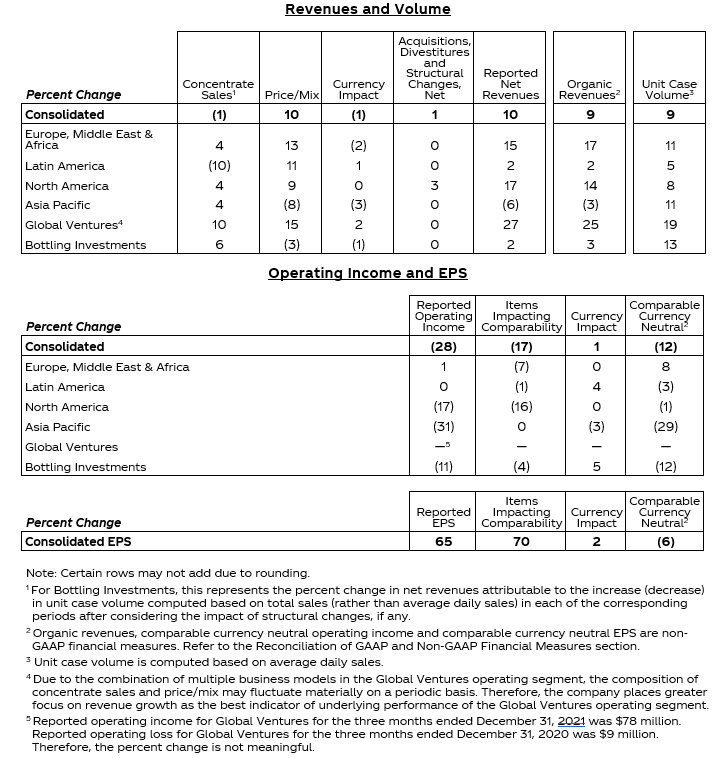
Operating Review – Year Ended December 31, 2021
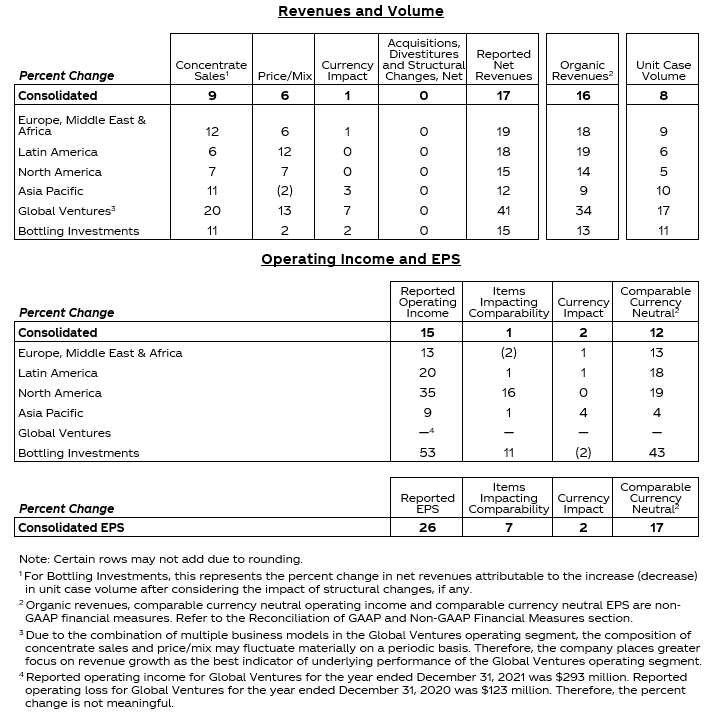
In addition to the data in the preceding tables, operating results included the following:
Consolidated
- Unit case volume grew 9% for the quarter and 8% for the year, resulting in volume ahead of 2019. Volume growth was strong across most markets. The volume performance was driven by investments in the marketplace, ongoing recovery in markets where coronavirus-related uncertainty was abating, and the benefit from cycling the impact of the pandemic in the prior year. For both the quarter and the year, growth in developing and emerging markets was led by China, India and Russia, while growth in developed markets was led by the United States, Mexico and the United Kingdom
Category performance was as follows:
- Sparkling soft drinks grew 8% for the quarter and 7% for the year, resulting in volume ahead of 2019, driven by strong performance across all geographic operating segments. Trademark Coca‑Cola grew 7% for both the quarter and the year, resulting in volume ahead of 2019, led by Europe, Middle East & Africa and Asia Pacific. Coca‑Cola® Zero Sugar grew double digits for both the quarter and the year. Sparkling flavors grew 9% for both the quarter and the year, led by Europe, Middle East & Africa and Asia Pacific.
- Nutrition, juice, dairy and plant-based beverages grew 11% for the quarter and 12% for the year, resulting in volume ahead of 2019. For both the quarter and the year, there was strong growth across all geographic operating segments.
- Hydration, sports, coffee and tea grew 12% for the quarter and 7% for the year. Hydration grew 11% for the quarter and 5% for the year, with growth across all geographic operating segments. Sports drinks grew 18% for the quarter and 13% for the year, resulting in volume ahead of 2019, primarily driven by strong growth of BODYARMOR in the United States. Tea grew 10% for the quarter and 6% for the year, led by growth in Japan and the United States. Coffee grew 17% for the quarter and 15% for the year, primarily driven by the ongoing reopening of Costa® retail stores in the United Kingdom.
- Price/mix grew 10% for the quarter and 6% for the year, driven by pricing actions in the marketplace along with favorable channel and package mix due to cycling the impact of the pandemic in the prior year. Price/mix for the quarter was further benefited by positive segment mix. For the quarter, concentrate sales were 10 points behind unit case volume. This was primarily attributable to six fewer days in the quarter, which resulted in an approximate 6-point impact on concentrate sales, along with the timing of concentrate shipments. For the full year, concentrate sales were 1 point ahead of unit case volume, primarily due to bottler inventory build to manage near-term supply disruption.
- Operating income declined 28% for the quarter and grew 15% for the year, which included items impacting comparability and currency tailwinds. Comparable currency neutral operating income (non-GAAP) declined 12% for the quarter, driven by a significant increase in marketing investments versus the prior year. Additionally, fourth quarter operating income was impacted by topline pressure from six fewer days in the quarter. Comparable currency neutral operating income (non-GAAP) grew 12% for the full year, driven by strong organic revenue (non-GAAP) growth across all operating segments, partially offset by a significant increase in marketing investments versus the prior year.
Europe, Middle East & Africa
- Unit case volume grew 11% for the quarter, a low single-digit increase versus 2019, driven by ongoing recovery in markets where coronavirus-related uncertainty was abating, along with the benefit from cycling the impact of the pandemic in the prior year. Growth was led by Russia and Spain in Europe, Nigeria in Africa, and Turkey in Eurasia and Middle East.
- Price/mix grew 13% for the quarter, driven by favorable channel and package mix due to cycling the impact of the pandemic in the prior year, along with positive geographic mix. For the quarter, concentrate sales were 7 points behind unit case volume, primarily due to six fewer days in the quarter.
- Operating income grew 1% for the quarter, which included items impacting comparability. Comparable currency neutral operating income (non-GAAP) grew 8% for the quarter, primarily driven by solid organic revenue (non-GAAP) growth across all operating units, partially offset by a significant increase in marketing investments versus the prior year.
- For the year, the company gained value share in total NARTD beverages, which included share gains across most categories.
Latin America
- Unit case volume grew 5% for the quarter, a mid single-digit increase versus 2019. Growth was led by Mexico, Argentina and Chile, driven by growth in most categories.
- Price/mix grew 11% for the quarter, driven by pricing actions in the marketplace, favorable channel and package mix, along with the timing of deductions. For the quarter, concentrate sales were 15 -points behind unit case volume, primarily due to six fewer days in the quarter and the timing of concentrate shipments.
- Operating income was even for the quarter, which included items impacting comparability and a 3-point currency tailwind. Comparable currency neutral operating income (non-GAAP) declined 3% for the quarter, driven by an increase in marketing investments versus the prior year.
- For the year, the company gained value share in total NARTD beverages, led by share gains in Mexico, Argentina, Brazil and Colombia.
North America
- Unit case volume grew 8% for the quarter, resulting in even performance versus 2019. Growth was driven by recovery in the fountain business as coronavirus-related uncertainty abated. Sparkling soft drinks and sports drinks led the growth during the quarter.
- Price/mix grew 9% for the quarter, primarily driven by pricing actions in the marketplace, recovery in the fountain business and away-from-home channels, and strong growth in premium offerings. For the quarter, concentrate sales were 4 points behind unit case volume, primarily due to six fewer days in the quarter.
- Operating income declined 17% for the quarter, which included items impacting comparability. Comparable currency neutral operating income (non-GAAP) declined 1% for the quarter, driven by a significant increase in marketing investments versus the prior year.
- The company gained value share in total NARTD beverages for the year, driven by recovery in away-from-home channels along with strong performance in at-home channels for sparkling flavors, sports drinks and dairy.
Asia Pacific
- Unit case volume grew 11% for the quarter, resulting in a low single-digit increase versus 2019. Growth was driven by China, India and the Philippines, partially offset by pressure in Australia due to the impact of the pandemic. Growth was led by Trademark Coca‑Cola and sparkling flavors.
- Price/mix declined 8% for the quarter due to negative channel mix in key markets along with 4 points of negative geographic mix due to growth in emerging and developing markets outpacing developed markets. For the quarter, concentrate sales were 7 points behind unit case volume, primarily due to six fewer days in the quarter.
- Operating income declined 31% for the quarter, which included a 2-point currency headwind. Comparable currency neutral operating income (non-GAAP) declined 29% for the quarter, driven by topline pressure along with a significant increase in marketing investments versus the prior year.
- The company’s value share in total NARTD beverages was even for the year, as strong underlying share gains in most markets were offset by the impact of negative geographic mix in the operating segment.
Global Ventures
- Net revenues grew 27% for the quarter, which included a 2-point currency tailwind. Organic revenues (non-GAAP) grew 25%. Revenue growth was primarily driven by the ongoing reopening of Costa retail stores in the United Kingdom.
- Operating income growth and comparable currency neutral operating income (non-GAAP) growth for the quarter were driven by strong organic revenue (non-GAAP) growth.
Bottling Investments
- Unit case volume grew 13% for the quarter, driven by strong growth in the key markets of India and the Philippines.
- Price/mix declined 3% for the quarter, primarily due to weather-related disruption and negative package mix in South Africa.
- Operating income declined 11% for the quarter, including items impacting comparability and a 5-point tailwind from currency. Comparable currency neutral operating income (non-GAAP) declined 12% for the quarter, driven by an increase in operating expenses versus the prior year.
Capital Allocation Update
- Reinvesting in the business: The company continued to invest in its various lines of business and spent $1.4 billion in capital expenditures in 2021, an increase of 16% versus the prior year.
- Continuing to grow the dividend: The company paid dividends totaling $7.3 billion during 2021. The company has increased its dividend in each of the last 59 years.
- Consumer-centric M&A: The company acquired the remaining 85% ownership interest in BODYARMOR, a line of sports performance and hydration beverages, in November 2021 for $5.6 billion.
- Share repurchases: In 2021, the company did not repurchase any shares under the existing share repurchase authorization. The company’s remaining share repurchase authorization is approximately $10 billion.
Outlook
The 2022 outlook information provided below includes forward-looking non-GAAP financial measures, which management uses in measuring performance. The company is not able to reconcile full-year 2022 projected organic revenues (non-GAAP) to full-year 2022 projected reported net revenues, full-year 2022 projected comparable net revenues (non-GAAP) to full-year 2022 projected reported net revenues, full-year 2022 projected comparable cost of goods sold (non-GAAP) to full-year 2022 projected reported cost of goods sold, full-year 2022 projected underlying effective tax rate (non-GAAP) to full-year 2022 projected reported effective tax rate, full-year 2022 projected comparable currency neutral EPS (non-GAAP) to full-year 2022 projected reported EPS or full-year 2022 projected comparable EPS (non-GAAP) to full-year 2022 projected reported EPS without unreasonable efforts because it is not possible to predict with a reasonable degree of certainty the actual impact of changes in foreign currency exchange rates throughout 2022; the exact timing and amount of acquisitions, divestitures and/or structural changes throughout 2022; the exact timing and amount of items impacting comparability throughout 2022; and the actual impact of changes in commodity costs throughout 2022. The unavailable information could have a significant impact on the company’s full-year 2022 reported financial results.
Full-Year 2022
The company expects to deliver organic revenue (non-GAAP) growth of 7% to 8%.
For comparable net revenues (non-GAAP), the company expects a 2% to 3% currency headwind based on the current rates and including the impact of hedged positions, in addition to a 3% tailwind from acquisitions.
The company expects commodity price inflation to be a mid single-digit percentage headwind on comparable cost of goods sold (non-GAAP), based on the current rates and including the impact of hedged positions.
The company’s underlying effective tax rate (non-GAAP) is estimated to be 20%. This does not include the impact of ongoing tax litigation with the U.S. Internal Revenue Service, if the company were not to prevail.
Given the above considerations, the company expects to deliver comparable currency neutral EPS (non-GAAP) growth of 8% to 10% and comparable EPS (non-GAAP) growth of 5% to 6%, versus $2.32 in 2021.
Comparable EPS (non-GAAP) percentage growth is expected to include a 3% to 4% currency headwind based on the current rates and including the impact of hedged positions, in addition to a minimal tailwind from acquisitions.
The company expects to generate free cash flow (non-GAAP) of approximately $10.5 billion through cash flow from operations of approximately $12.0 billion, less capital expenditures of approximately $1.5 billion. This does not include any potential payments related to ongoing tax litigation with the U.S. Internal Revenue Service.
First Quarter 2022 Considerations
Comparable net revenues (non-GAAP) are expected to include an approximate 3% currency headwind based on the current rates and including the impact of hedged positions, in addition to a 3% tailwind from acquisitions.
Comparable EPS (non-GAAP) percentage growth is expected to include an approximate 5% currency headwind based on the current rates and including the impact of hedged positions.
The first quarter has one less day compared to first quarter 2021.
Notes
- All references to growth rate percentages and share compare the results of the period to those of the prior year comparable period, unless otherwise noted.
- All references to volume and volume percentage changes indicate unit case volume, unless otherwise noted. All volume percentage changes are computed based on average daily sales for the fourth quarter, unless otherwise noted, and are computed on a reported basis for the full year. “Unit case” means a unit of measurement equal to 192 U.S. fluid ounces of finished beverage (24 eight-ounce servings), with the exception of unit case equivalents for Costa non-ready-to-drink beverage products which are primarily measured in number of transactions. “Unit case volume” means the number of unit cases (or unit case equivalents) of company beverages directly or indirectly sold by the company and its bottling partners to customers or consumers.
- “Concentrate sales” represents the amount of concentrates, syrups, beverage bases, source waters and powders/minerals (in all instances expressed in equivalent unit cases) sold by, or used in finished beverages sold by, the company to its bottling partners or other customers. For Costa non-ready-to-drink beverage products, “concentrate sales” represents the amount of coffee (in all instances expressed in equivalent unit cases) sold by the company to customers or consumers. In the reconciliation of reported net revenues, “concentrate sales” represents the percent change in net revenues attributable to the increase (decrease) in concentrate sales volume for the geographic operating segments and the Global Ventures operating segment after considering the impact of structural changes, if any. For the Bottling Investments operating segment for the fourth quarter, this represents the percent change in net revenues attributable to the increase (decrease) in unit case volume computed based on total sales (rather than average daily sales) in each of the corresponding periods after considering the impact of structural changes, if any. For the Bottling Investments operating segment for the full year, this represents the percent change in net revenues attributable to the increase (decrease) in unit case volume after considering the impact of structural changes, if any. The Bottling Investments operating segment reflects unit case volume growth for consolidated bottlers only.
- “Price/mix” represents the change in net operating revenues caused by factors such as price changes, the mix of products and packages sold, and the mix of channels and geographic territories where the sales occurred.
- First quarter 2021 financial results were impacted by five additional days as compared to first quarter 2020, and fourth quarter 2021 financial results were impacted by six fewer days as compared to fourth quarter 2020. Unit case volume results for the quarters are not impacted by the variances in days due to the average daily sales computation referenced above.
Conference Call
The company is hosting a conference call with investors and analysts to discuss fourth quarter and full-year 2021 operating results today, Feb. 10, 2022, at 8:30 a.m. ET. The company invites participants to listen to a live webcast of the conference call on the company’s website, http://www.coca-colacompany.com, in the “Investors” section. An audio replay in downloadable digital format and a transcript of the call will be available on the website within 24 hours following the call. Further, the “Investors” section of the website includes certain supplemental information and a reconciliation of non-GAAP financial measures to the company’s results as reported under GAAP, which may be used during the call when discussing financial results.
Forward-Looking Statements
This press release may contain statements, estimates or projections that constitute “forward-looking statements” as defined under U.S. federal securities laws. Generally, the words “believe,” “expect,” “intend,” “estimate,” “anticipate,” “project,” “will” and similar expressions identify forward-looking statements, which generally are not historical in nature. Forward-looking statements are subject to certain risks and uncertainties that could cause The Coca‑Cola Company’s actual results to differ materially from its historical experience and our present expectations or projections. These risks include, but are not limited to, the negative impacts of, and continuing uncertainties associated with the scope, severity and duration of the global COVID-19 pandemic and any resurgences of the pandemic, including the number of people contracting the virus, the impact of shelter-in-place and social distancing requirements, the impact of governmental actions across the globe to contain the virus, vaccine availability, rates of vaccination, the effectiveness of vaccines against existing and new variants of the virus, governmental or other vaccine mandates and potential associated business and supply chain disruptions, and the substance and pace of the post-pandemic economic recovery; an inability to realize the economic benefits from our productivity initiatives, including our reorganization and related strategic realignment initiatives; an inability to attract or retain a highly skilled and diverse workforce; increased competition; an inability to renew collective bargaining agreements on satisfactory terms, or we or our bottling partners experience strikes, work stoppages, labor shortages or labor unrest; an inability to be successful in our innovation activities; changes in the retail landscape or the loss of key retail or foodservice customers; an inability to expand operations in emerging and developing markets; increased cost, disruption of supply or shortage of energy or fuel; inflationary pressures; increased cost, disruption of supply or shortage of ingredients, other raw materials, packaging materials, aluminum cans and other containers; an inability to successfully manage new product launches; obesity and other health-related concerns; evolving consumer product and shopping preferences; product safety and quality concerns; perceived negative health consequences of certain ingredients, such as non-nutritive sweeteners and biotechnology-derived substances, and of other substances present in our beverage products or packaging materials; damage to our brand image, corporate reputation and social license to operate from negative publicity, whether or not warranted, concerning product safety or quality, workplace and human rights, obesity or other issues; an inability to maintain good relationships with our bottling partners; deterioration in our bottling partners’ financial condition; an inability to successfully integrate and manage consolidated bottling operations or other acquired businesses or brands; an inability to successfully manage our refranchising activities; increases in income tax rates, changes in income tax laws or the unfavorable resolution of tax matters, including the outcome of our ongoing tax dispute or any related disputes with the U.S. Internal Revenue Service (“IRS”); the possibility that the assumptions used to calculate our estimated aggregate incremental tax and interest liability related to the potential unfavorable outcome of the ongoing tax dispute with the IRS could significantly change; increased or new indirect taxes in the United States and throughout the world; changes in laws and regulations relating to beverage containers and packaging; significant additional labeling or warning requirements or limitations on the marketing or sale of our products; litigation or legal proceedings; conducting business in markets with high-risk legal compliance environments; failure to adequately protect, or disputes relating to, trademarks, formulae and other intellectual property rights; changes in, or failure to comply with, the laws and regulations applicable to our products or our business operations; fluctuations in foreign currency exchange rates; interest rate increases; unfavorable general economic conditions in the United States and international markets; an inability to achieve our overall long-term growth objectives; default by or failure of one or more of our counterparty financial institutions; impairment charges; failure to realize a significant portion of the anticipated benefits of our strategic relationship with Monster Beverage Corporation; an inability to protect our information systems against service interruption, misappropriation of data or breaches of security; failure to comply with personal data protection and privacy laws; failure to digitize the Coca‑Cola system; failure by our third-party service providers and business partners to satisfactorily fulfill their commitments and responsibilities; failure to achieve ESG goals and accurately report our progress due to operational, financial, legal, and other risks, many of which are outside our control, and are dependent on the actions of our bottling partners and other third parties; increasing concerns about the environmental impact of plastic bottles and other packaging materials; water scarcity and poor quality; increased demand for food products and decreased agricultural productivity; climate change and legal or regulatory responses thereto; adverse weather conditions; and other risks discussed in our filings with the Securities and Exchange Commission (the “SEC”), including our Annual Report on Form 10-K for the year ended December 31, 2020 and our subsequently filed Quarterly Reports on Form 10-Q, which filings are available from the SEC. You should not place undue reliance on forward-looking statements, which speak only as of the date they are made. We undertake no obligation to publicly update or revise any forward-looking statements.
